Nghiên cứu cải thiện khả năng phát âm của sinh viên chuyên ngữ năm nhất tại trường Đại học Quy Nhơn trong khóa Luyện âm
Phát âm là yếu tố đóng vai trò then chốt trong kĩ năng nói. Tuy nhiên các lớp học tiếng Anh chính quy ở trường phổ thông tại Việt Nam vẫn chưa dành sự chú ý đúng mức cho phương diện này cho đến khi các em học chuyên sâu hơn trong khóa học Luyện âm ở đại học cho sinh viên chuyên ngữ năm thứ nhất. Nghiên cứu này nhằm điều tra hiệu quả của việc áp dụng của hai phương pháp hỗ trợ Shadowing (phương pháp nghe và lặp lại) và Feedback (phương pháp phản hồi) ngoài chương trình chính khóa của sinh viên nhằm cải thiện khả năng phát âm của sinh viên chuyên ngữ, đặc biệt là sinh viên ngành sư phạm. Thực nghiệm kéo dài trong một học kì, tiến hành trên 67 sinh viên năm thứ nhất, khoa Ngoại ngữ, trường Đại học Quy Nhơn. Những người tham gia được chia thành 2 nhóm, nhóm thực nghiệm (n=43) và nhóm đối chứng (n=24). Dữ liệu được thu thập qua các bài kiểm tra trước và sau thực nghiệm, sau đó được phân tích thống kê. Kết quả cho thấy các sinh viên trong nhóm thực nghiệm đã có nhiều tiến bộ sau khóa học, đặc biệt trong việc thể hiện trọng âm của câu, điều này cho thấy tính hiệu quả của các phương pháp thực nghiệm. Kết quả phân tích cũng cho thấy sự tiến bộ khiêm tốn của nhóm thực nghiệm so với nhóm đối chứng trong việc khắc phục lỗi phát âm âm cuối (“ed”, “s/es”) và nối âm đã chỉ ra một thực tế là tinh thần tự học của sinh viên còn thấp
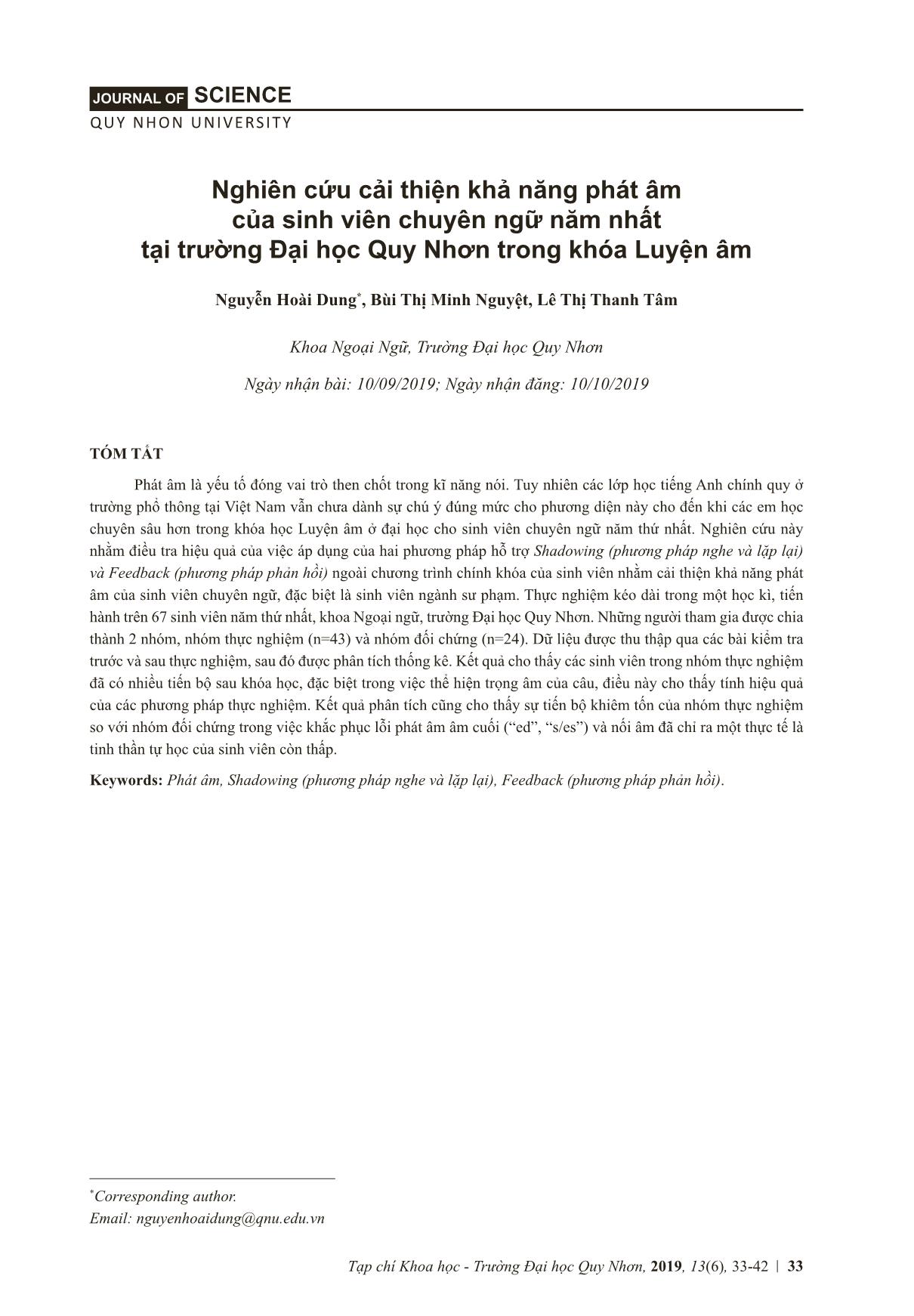
Trang 1
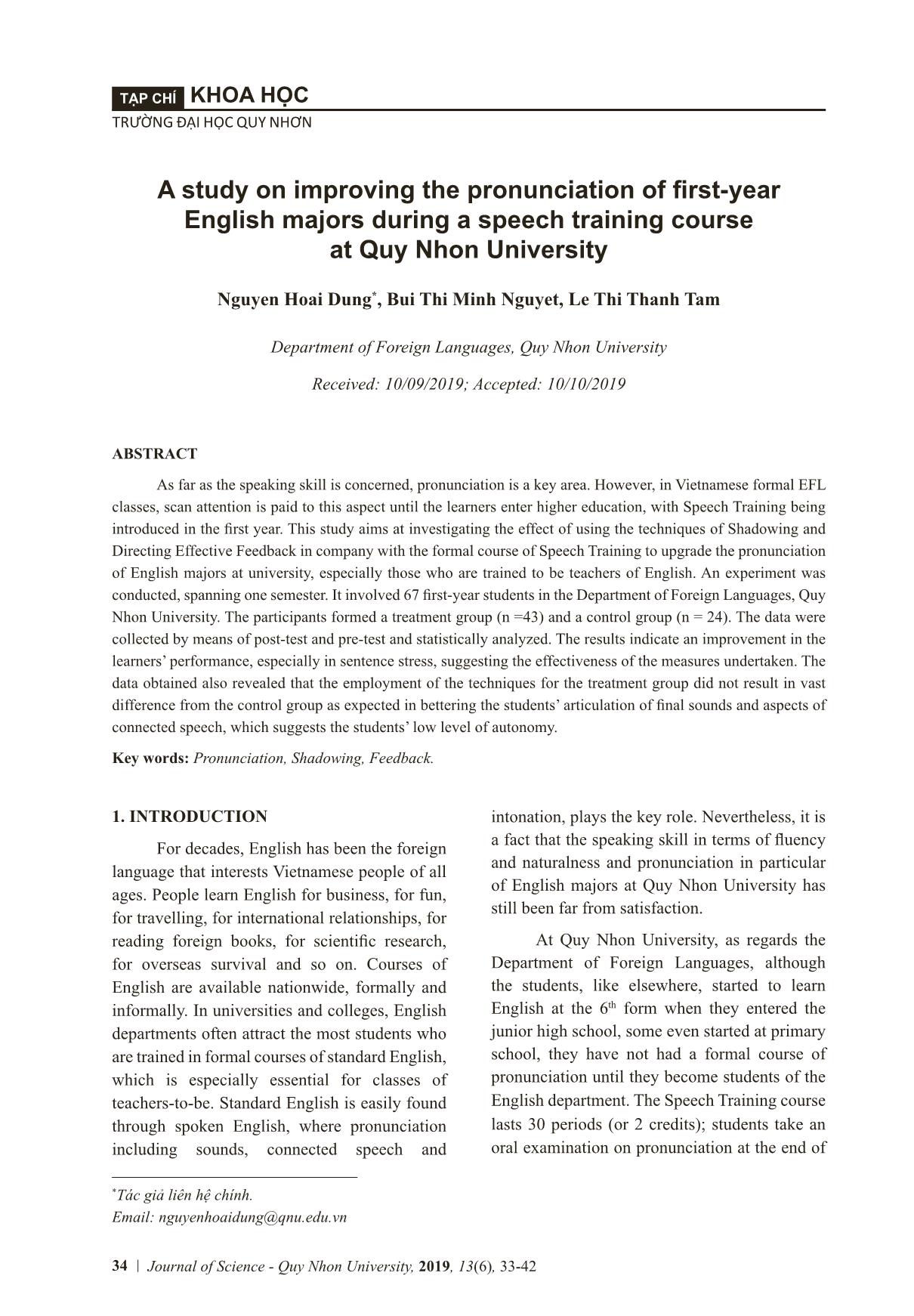
Trang 2
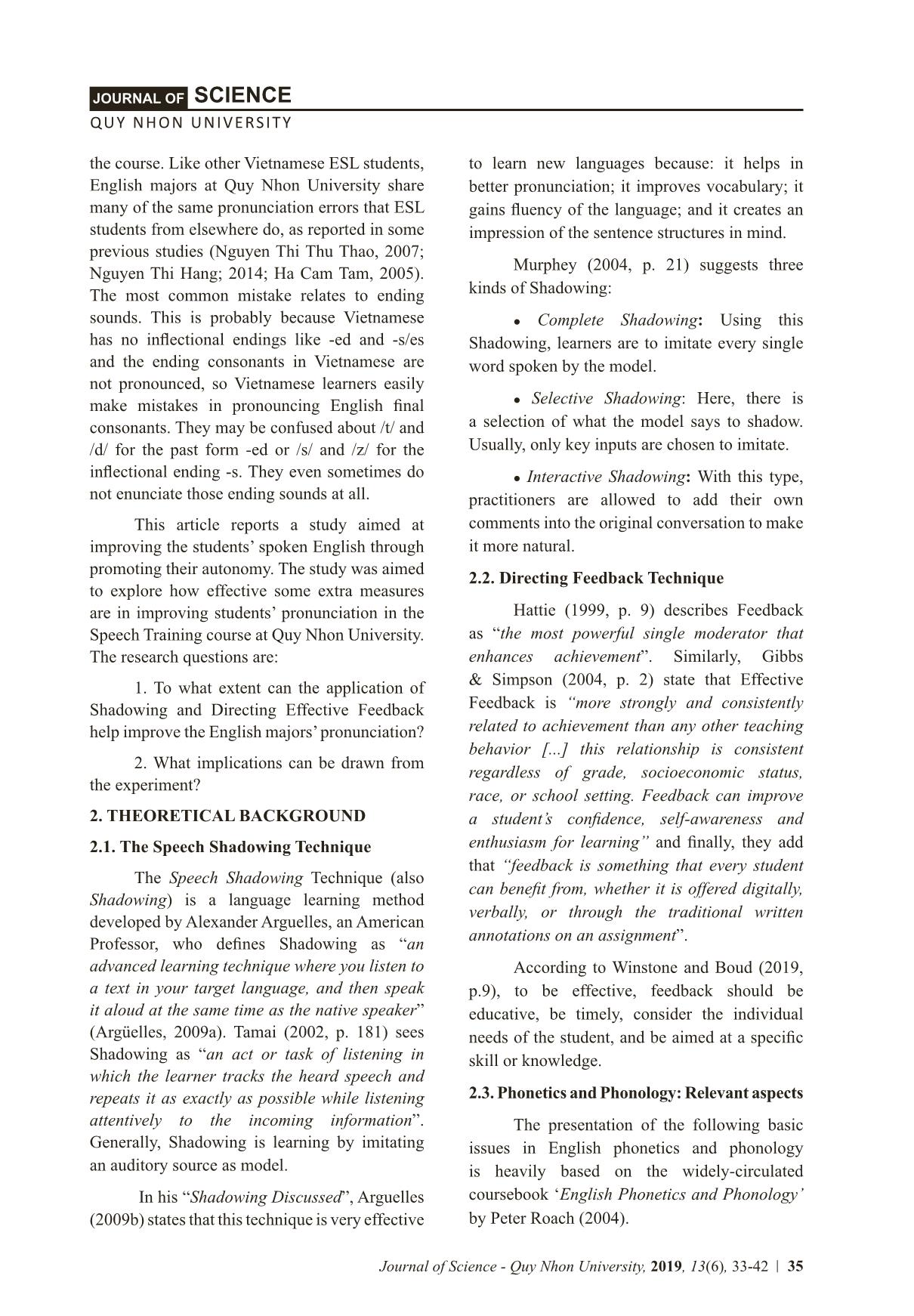
Trang 3
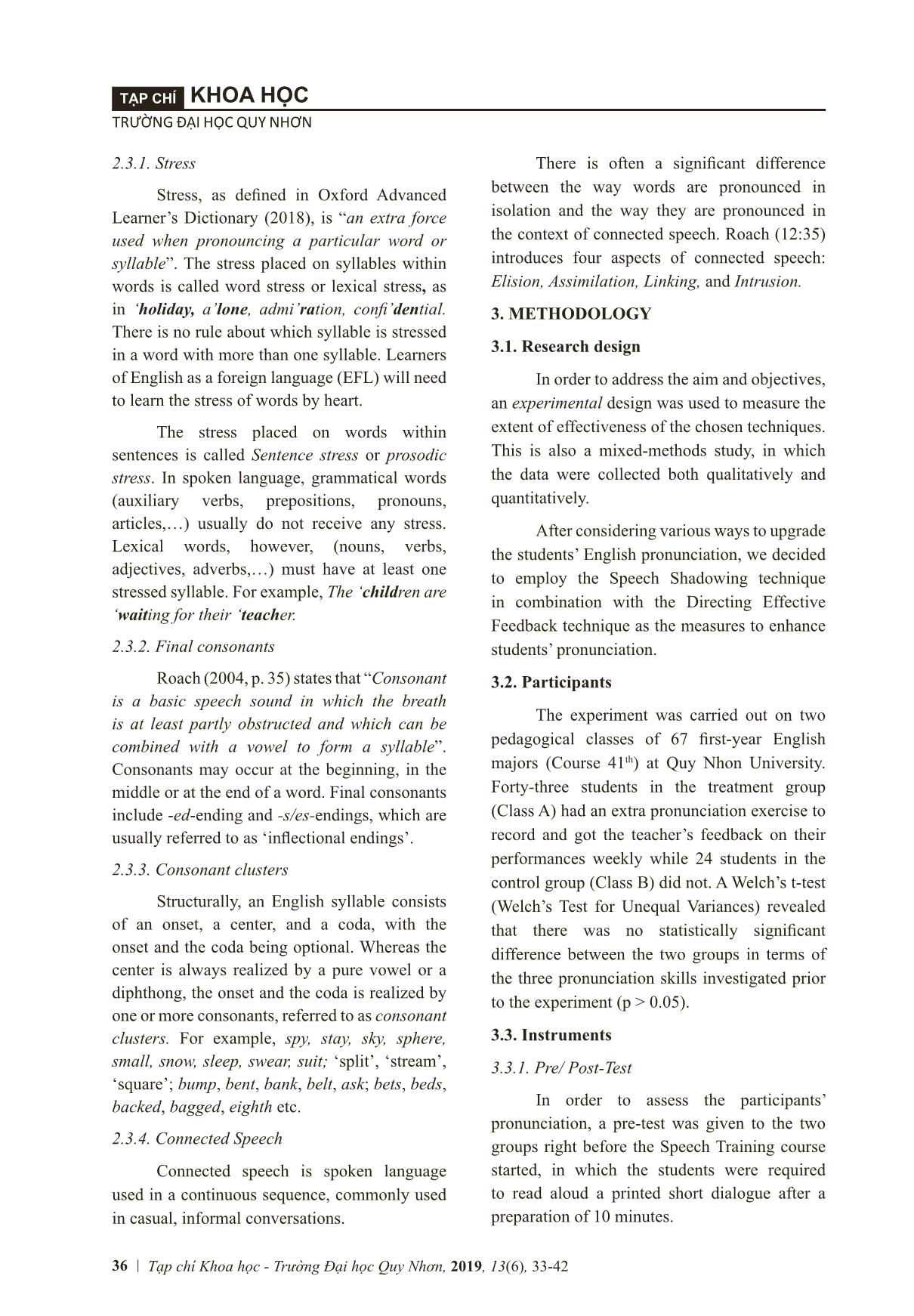
Trang 4
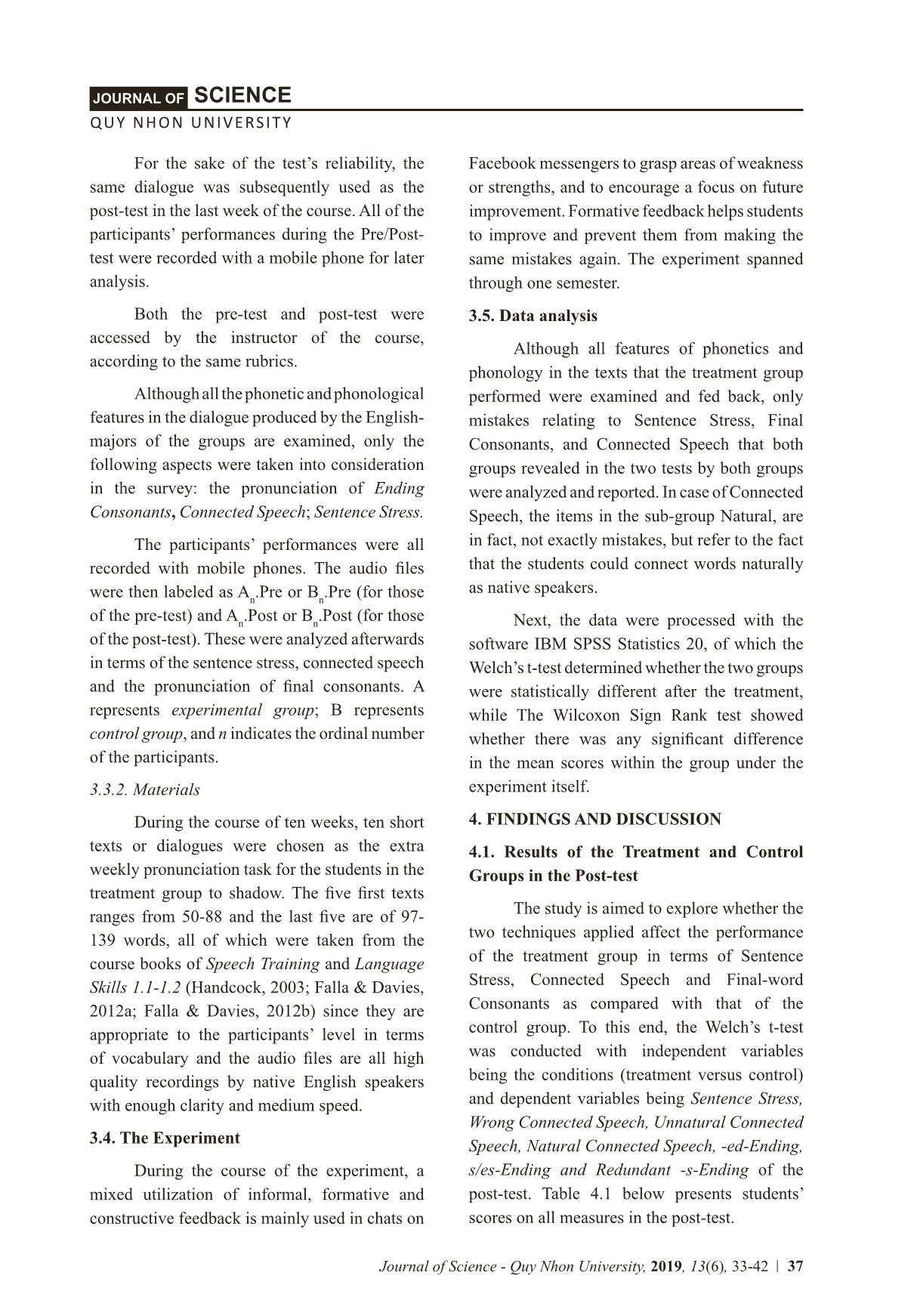
Trang 5
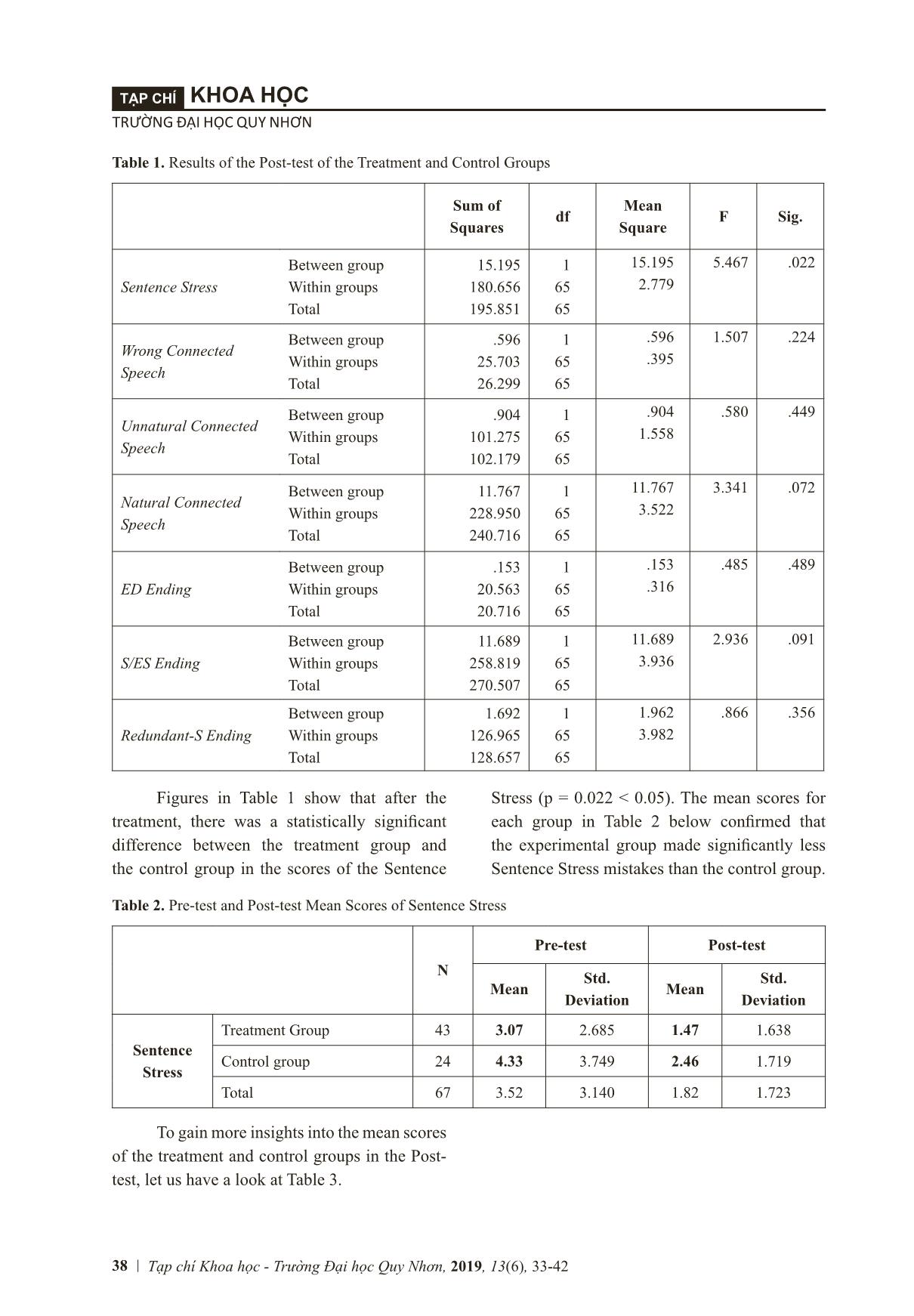
Trang 6
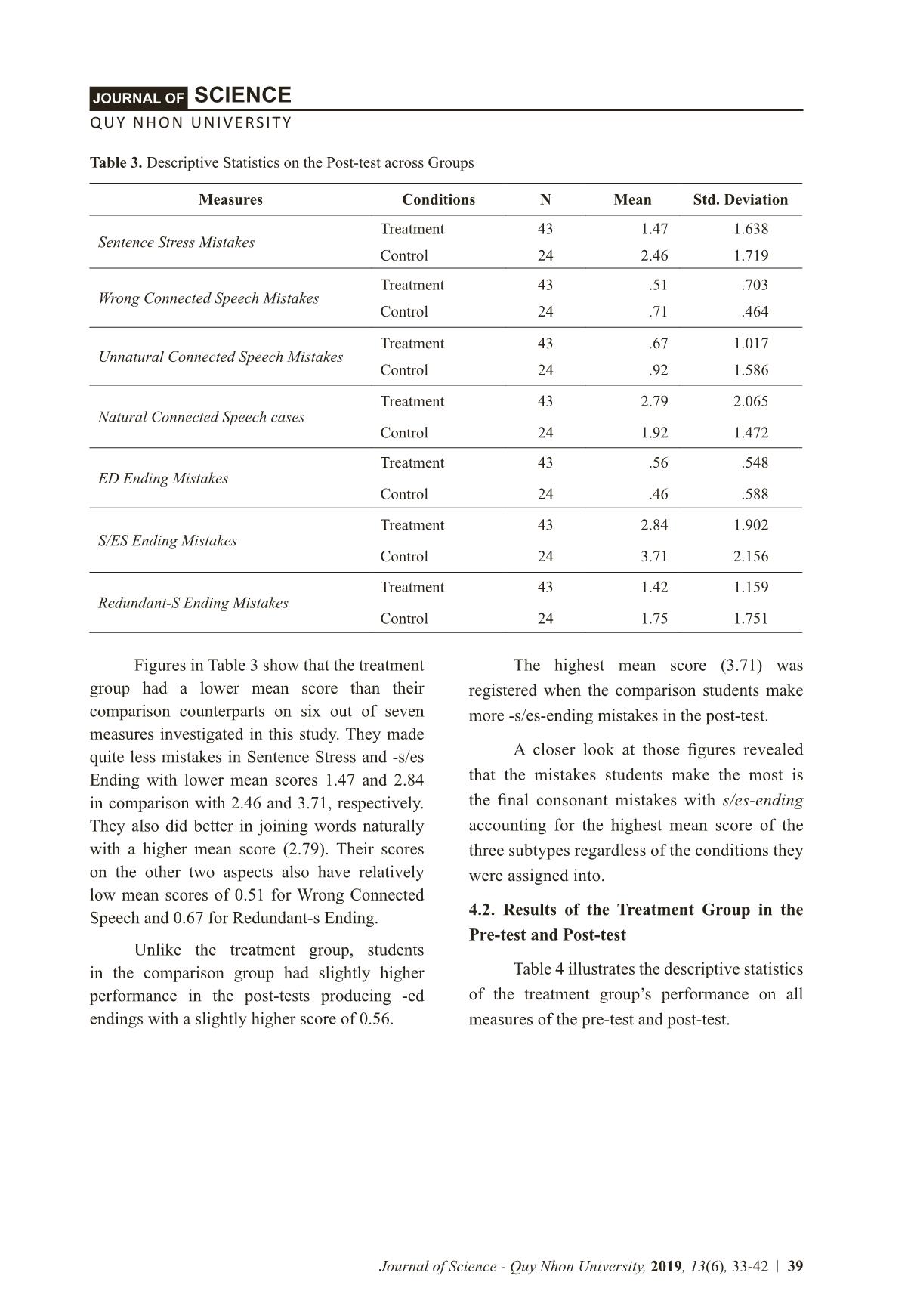
Trang 7
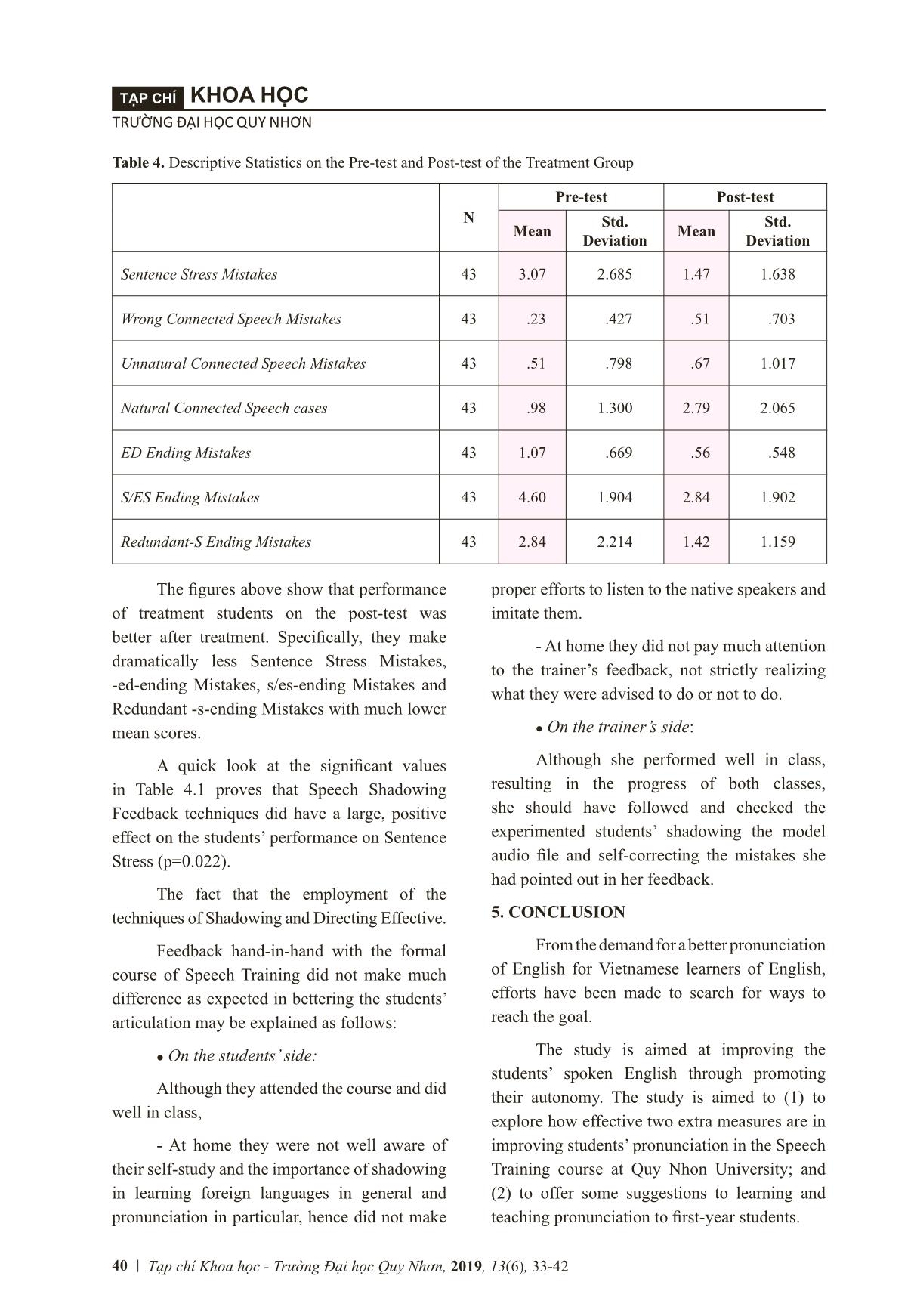
Trang 8
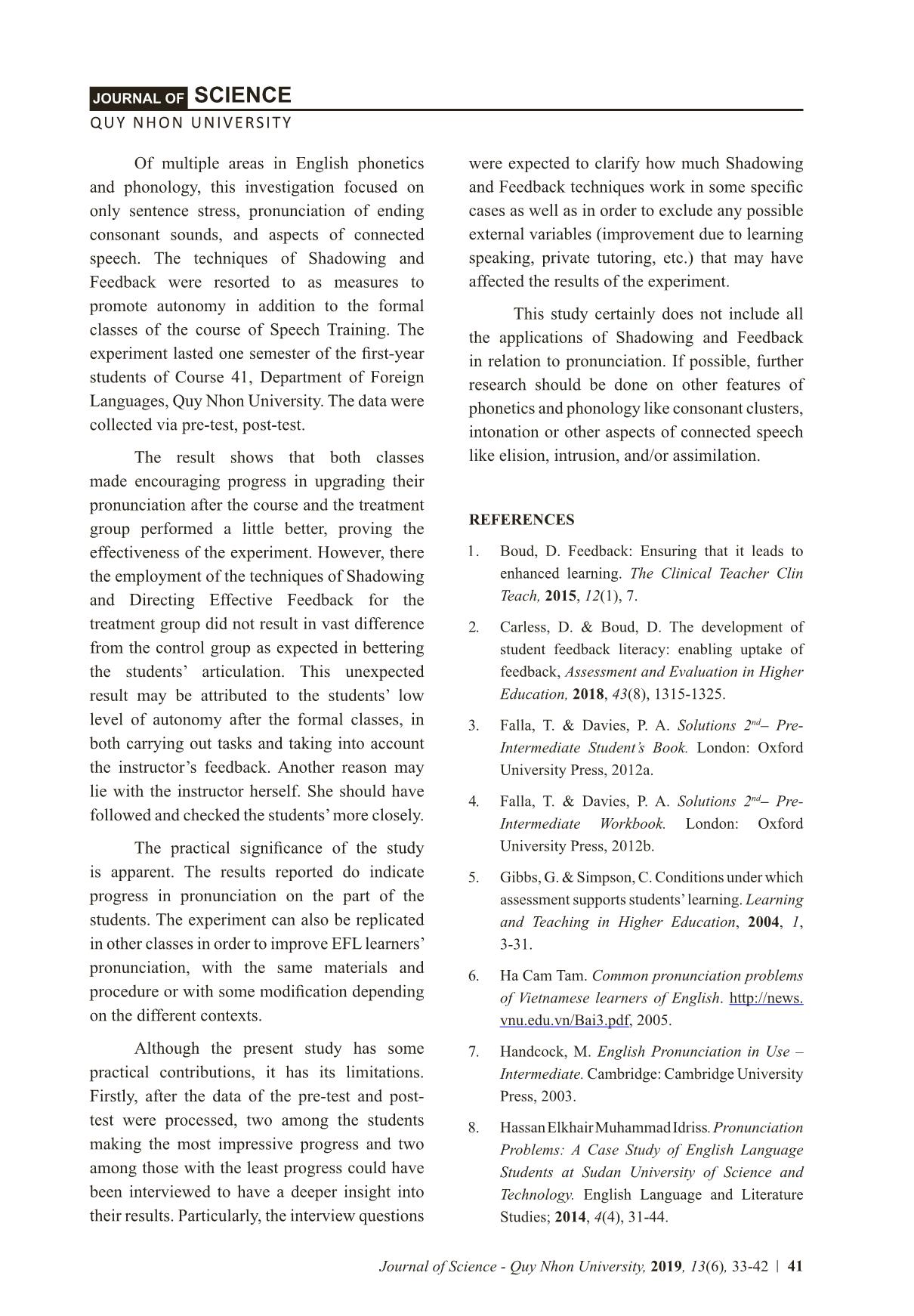
Trang 9
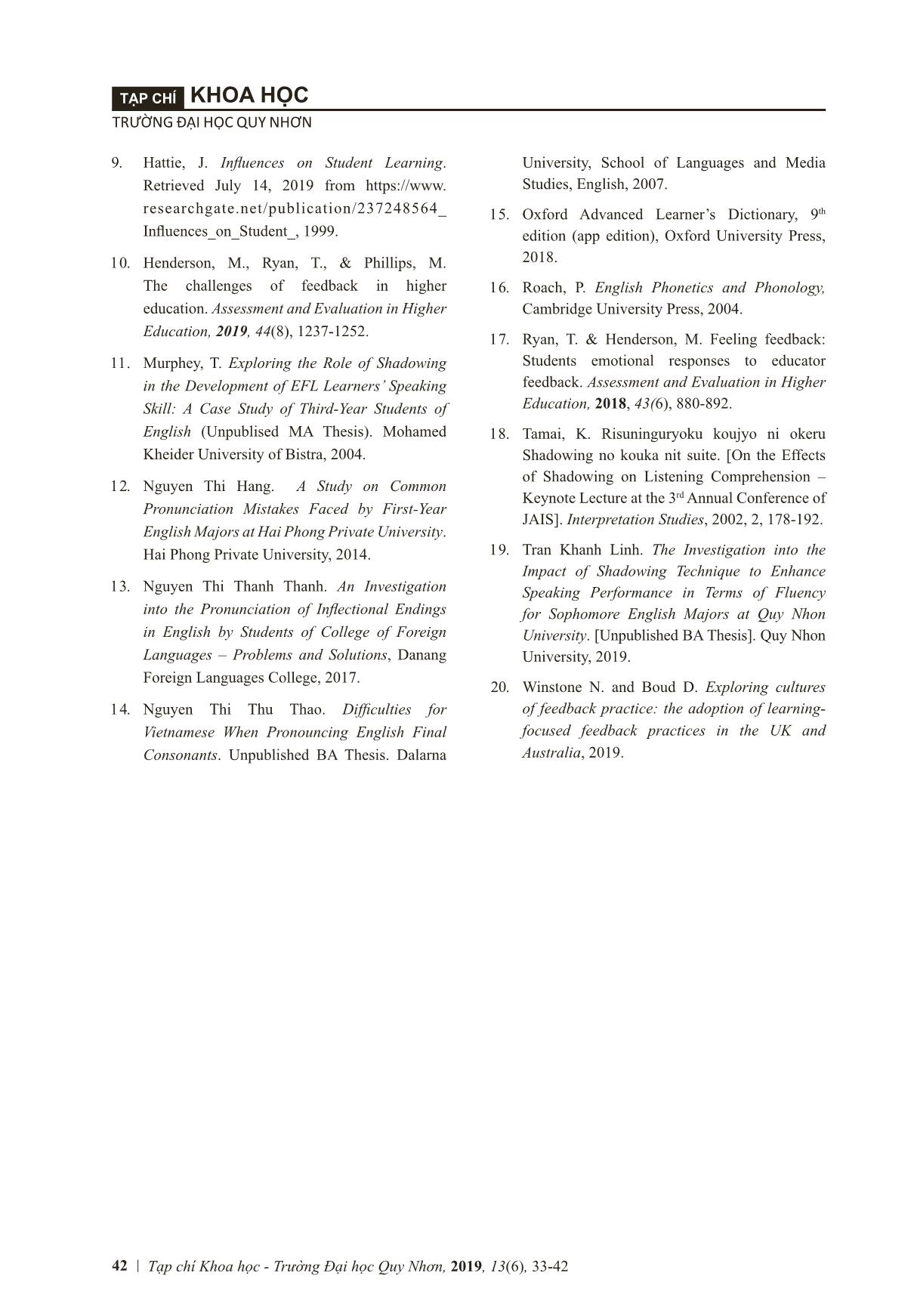
Trang 10
Tóm tắt nội dung tài liệu: Nghiên cứu cải thiện khả năng phát âm của sinh viên chuyên ngữ năm nhất tại trường Đại học Quy Nhơn trong khóa Luyện âm
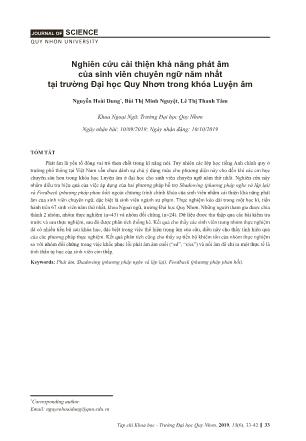
uality recordings by native English speakers with enough clarity and medium speed. 3.4. The Experiment During the course of the experiment, a mixed utilization of informal, formative and constructive feedback is mainly used in chats on Facebook messengers to grasp areas of weakness or strengths, and to encourage a focus on future improvement. Formative feedback helps students to improve and prevent them from making the same mistakes again. The experiment spanned through one semester. 3.5. Data analysis Although all features of phonetics and phonology in the texts that the treatment group performed were examined and fed back, only mistakes relating to Sentence Stress, Final Consonants, and Connected Speech that both groups revealed in the two tests by both groups were analyzed and reported. In case of Connected Speech, the items in the sub-group Natural, are in fact, not exactly mistakes, but refer to the fact that the students could connect words naturally as native speakers. Next, the data were processed with the software IBM SPSS Statistics 20, of which the Welch’s t-test determined whether the two groups were statistically different after the treatment, while The Wilcoxon Sign Rank test showed whether there was any significant difference in the mean scores within the group under the experiment itself. 4. FINDINGS AND DISCUSSION 4.1. Results of the Treatment and Control Groups in the Post-test The study is aimed to explore whether the two techniques applied affect the performance of the treatment group in terms of Sentence Stress, Connected Speech and Final-word Consonants as compared with that of the control group. To this end, the Welch’s t-test was conducted with independent variables being the conditions (treatment versus control) and dependent variables being Sentence Stress, Wrong Connected Speech, Unnatural Connected Speech, Natural Connected Speech, -ed-Ending, s/es-Ending and Redundant -s-Ending of the post-test. Table 4.1 below presents students’ scores on all measures in the post-test. 38 TRƯỜNG ĐẠI HỌC QUY NHƠN KHOA HỌCTẠP CHÍ Tạp chí Khoa học - Trường Đại học Quy Nhơn, 2019, 13(6), 33-42 Table 1. Results of the Post-test of the Treatment and Control Groups Sum of Squares df Mean Square F Sig. Sentence Stress Between group Within groups Total 15.195 180.656 195.851 1 65 65 15.195 2.779 5.467 .022 Wrong Connected Speech Between group Within groups Total .596 25.703 26.299 1 65 65 .596 .395 1.507 .224 Unnatural Connected Speech Between group Within groups Total .904 101.275 102.179 1 65 65 .904 1.558 .580 .449 Natural Connected Speech Between group Within groups Total 11.767 228.950 240.716 1 65 65 11.767 3.522 3.341 .072 ED Ending Between group Within groups Total .153 20.563 20.716 1 65 65 .153 .316 .485 .489 S/ES Ending Between group Within groups Total 11.689 258.819 270.507 1 65 65 11.689 3.936 2.936 .091 Redundant-S Ending Between group Within groups Total 1.692 126.965 128.657 1 65 65 1.962 3.982 .866 .356 Figures in Table 1 show that after the treatment, there was a statistically significant difference between the treatment group and the control group in the scores of the Sentence Stress (p = 0.022 < 0.05). The mean scores for each group in Table 2 below confirmed that the experimental group made significantly less Sentence Stress mistakes than the control group. Table 2. Pre-test and Post-test Mean Scores of Sentence Stress N Pre-test Post-test Mean Std. Deviation Mean Std. Deviation Sentence Stress Treatment Group 43 3.07 2.685 1.47 1.638 Control group 24 4.33 3.749 2.46 1.719 Total 67 3.52 3.140 1.82 1.723 To gain more insights into the mean scores of the treatment and control groups in the Post- test, let us have a look at Table 3. 39 QUY NHON UNIVERSITY SCIENCEJOURNAL OF Journal of Science - Quy Nhon University, 2019, 13(6), 33-42 Table 3. Descriptive Statistics on the Post-test across Groups Measures Conditions N Mean Std. Deviation Sentence Stress Mistakes Treatment Control 43 24 1.47 2.46 1.638 1.719 Wrong Connected Speech Mistakes Treatment Control 43 24 .51 .71 .703 .464 Unnatural Connected Speech Mistakes Treatment Control 43 24 .67 .92 1.017 1.586 Natural Connected Speech cases Treatment Control 43 24 2.79 1.92 2.065 1.472 ED Ending Mistakes Treatment Control 43 24 .56 .46 .548 .588 S/ES Ending Mistakes Treatment Control 43 24 2.84 3.71 1.902 2.156 Redundant-S Ending Mistakes Treatment Control 43 24 1.42 1.75 1.159 1.751 The highest mean score (3.71) was registered when the comparison students make more -s/es-ending mistakes in the post-test. A closer look at those figures revealed that the mistakes students make the most is the final consonant mistakes with s/es-ending accounting for the highest mean score of the three subtypes regardless of the conditions they were assigned into. 4.2. Results of the Treatment Group in the Pre-test and Post-test Table 4 illustrates the descriptive statistics of the treatment group’s performance on all measures of the pre-test and post-test. Figures in Table 3 show that the treatment group had a lower mean score than their comparison counterparts on six out of seven measures investigated in this study. They made quite less mistakes in Sentence Stress and -s/es Ending with lower mean scores 1.47 and 2.84 in comparison with 2.46 and 3.71, respectively. They also did better in joining words naturally with a higher mean score (2.79). Their scores on the other two aspects also have relatively low mean scores of 0.51 for Wrong Connected Speech and 0.67 for Redundant-s Ending. Unlike the treatment group, students in the comparison group had slightly higher performance in the post-tests producing -ed endings with a slightly higher score of 0.56. 40 TRƯỜNG ĐẠI HỌC QUY NHƠN KHOA HỌCTẠP CHÍ Tạp chí Khoa học - Trường Đại học Quy Nhơn, 2019, 13(6), 33-42 Table 4. Descriptive Statistics on the Pre-test and Post-test of the Treatment Group N Pre-test Post-test Mean Std. Deviation Mean Std. Deviation Sentence Stress Mistakes 43 3.07 2.685 1.47 1.638 Wrong Connected Speech Mistakes 43 .23 .427 .51 .703 Unnatural Connected Speech Mistakes 43 .51 .798 .67 1.017 Natural Connected Speech cases 43 .98 1.300 2.79 2.065 ED Ending Mistakes 43 1.07 .669 .56 .548 S/ES Ending Mistakes 43 4.60 1.904 2.84 1.902 Redundant-S Ending Mistakes 43 2.84 2.214 1.42 1.159 proper efforts to listen to the native speakers and imitate them. - At home they did not pay much attention to the trainer’s feedback, not strictly realizing what they were advised to do or not to do. l On the trainer’s side: Although she performed well in class, resulting in the progress of both classes, she should have followed and checked the experimented students’ shadowing the model audio file and self-correcting the mistakes she had pointed out in her feedback. 5. CONCLUSION From the demand for a better pronunciation of English for Vietnamese learners of English, efforts have been made to search for ways to reach the goal. The study is aimed at improving the students’ spoken English through promoting their autonomy. The study is aimed to (1) to explore how effective two extra measures are in improving students’ pronunciation in the Speech Training course at Quy Nhon University; and (2) to offer some suggestions to learning and teaching pronunciation to first-year students. The figures above show that performance of treatment students on the post-test was better after treatment. Specifically, they make dramatically less Sentence Stress Mistakes, -ed-ending Mistakes, s/es-ending Mistakes and Redundant -s-ending Mistakes with much lower mean scores. A quick look at the significant values in Table 4.1 proves that Speech Shadowing Feedback techniques did have a large, positive effect on the students’ performance on Sentence Stress (p=0.022). The fact that the employment of the techniques of Shadowing and Directing Effective. Feedback hand-in-hand with the formal course of Speech Training did not make much difference as expected in bettering the students’ articulation may be explained as follows: l On the students’ side: Although they attended the course and did well in class, - At home they were not well aware of their self-study and the importance of shadowing in learning foreign languages in general and pronunciation in particular, hence did not make 41 QUY NHON UNIVERSITY SCIENCEJOURNAL OF Journal of Science - Quy Nhon University, 2019, 13(6), 33-42 Of multiple areas in English phonetics and phonology, this investigation focused on only sentence stress, pronunciation of ending consonant sounds, and aspects of connected speech. The techniques of Shadowing and Feedback were resorted to as measures to promote autonomy in addition to the formal classes of the course of Speech Training. The experiment lasted one semester of the first-year students of Course 41, Department of Foreign Languages, Quy Nhon University. The data were collected via pre-test, post-test. The result shows that both classes made encouraging progress in upgrading their pronunciation after the course and the treatment group performed a little better, proving the effectiveness of the experiment. However, there the employment of the techniques of Shadowing and Directing Effective Feedback for the treatment group did not result in vast difference from the control group as expected in bettering the students’ articulation. This unexpected result may be attributed to the students’ low level of autonomy after the formal classes, in both carrying out tasks and taking into account the instructor’s feedback. Another reason may lie with the instructor herself. She should have followed and checked the students’ more closely. The practical significance of the study is apparent. The results reported do indicate progress in pronunciation on the part of the students. The experiment can also be replicated in other classes in order to improve EFL learners’ pronunciation, with the same materials and procedure or with some modification depending on the different contexts. Although the present study has some practical contributions, it has its limitations. Firstly, after the data of the pre-test and post- test were processed, two among the students making the most impressive progress and two among those with the least progress could have been interviewed to have a deeper insight into their results. Particularly, the interview questions were expected to clarify how much Shadowing and Feedback techniques work in some specific cases as well as in order to exclude any possible external variables (improvement due to learning speaking, private tutoring, etc.) that may have affected the results of the experiment. This study certainly does not include all the applications of Shadowing and Feedback in relation to pronunciation. If possible, further research should be done on other features of phonetics and phonology like consonant clusters, intonation or other aspects of connected speech like elision, intrusion, and/or assimilation. REFERENCES 1. Boud, D. Feedback: Ensuring that it leads to enhanced learning. The Clinical Teacher Clin Teach, 2015, 12(1), 7. 2. Carless, D. & Boud, D. The development of student feedback literacy: enabling uptake of feedback, Assessment and Evaluation in Higher Education, 2018, 43(8), 1315-1325. 3. Falla, T. & Davies, P. A. Solutions 2nd– Pre- Intermediate Student’s Book. London: Oxford University Press, 2012a. 4. Falla, T. & Davies, P. A. Solutions 2nd– Pre- Intermediate Workbook. London: Oxford University Press, 2012b. 5. Gibbs, G. & Simpson, C. Conditions under which assessment supports students’ learning. Learning and Teaching in Higher Education, 2004, 1, 3-31. 6. Ha Cam Tam. Common pronunciation problems of Vietnamese learners of English. vnu.edu.vn/Bai3.pdf, 2005. 7. Handcock, M. English Pronunciation in Use – Intermediate. Cambridge: Cambridge University Press, 2003. 8. Hassan Elkhair Muhammad Idriss. Pronunciation Problems: A Case Study of English Language Students at Sudan University of Science and Technology. English Language and Literature Studies; 2014, 4(4), 31-44. 42 TRƯỜNG ĐẠI HỌC QUY NHƠN KHOA HỌCTẠP CHÍ Tạp chí Khoa học - Trường Đại học Quy Nhơn, 2019, 13(6), 33-42 9. Hattie, J. Influences on Student Learning. Retrieved July 14, 2019 from https://www. researchgate.net/publication/237248564_ Influences_on_Student_, 1999. 10. Henderson, M., Ryan, T., & Phillips, M. The challenges of feedback in higher education. Assessment and Evaluation in Higher Education, 2019, 44(8), 1237-1252. 11. Murphey, T. Exploring the Role of Shadowing in the Development of EFL Learners’ Speaking Skill: A Case Study of Third-Year Students of English (Unpublised MA Thesis). Mohamed Kheider University of Bistra, 2004. 12. Nguyen Thi Hang. A Study on Common Pronunciation Mistakes Faced by First-Year English Majors at Hai Phong Private University. Hai Phong Private University, 2014. 13. Nguyen Thi Thanh Thanh. An Investigation into the Pronunciation of Inflectional Endings in English by Students of College of Foreign Languages – Problems and Solutions, Danang Foreign Languages College, 2017. 14. Nguyen Thi Thu Thao. Difficulties for Vietnamese When Pronouncing English Final Consonants. Unpublished BA Thesis. Dalarna University, School of Languages and Media Studies, English, 2007. 15. Oxford Advanced Learner’s Dictionary, 9th edition (app edition), Oxford University Press, 2018. 16. Roach, P. English Phonetics and Phonology, Cambridge University Press, 2004. 17. Ryan, T. & Henderson, M. Feeling feedback: Students emotional responses to educator feedback. Assessment and Evaluation in Higher Education, 2018, 43(6), 880-892. 18. Tamai, K. Risuninguryoku koujyo ni okeru Shadowing no kouka nit suite. [On the Effects of Shadowing on Listening Comprehension – Keynote Lecture at the 3rd Annual Conference of JAIS]. Interpretation Studies, 2002, 2, 178-192. 19. Tran Khanh Linh. The Investigation into the Impact of Shadowing Technique to Enhance Speaking Performance in Terms of Fluency for Sophomore English Majors at Quy Nhon University. [Unpublished BA Thesis]. Quy Nhon University, 2019. 20. Winstone N. and Boud D. Exploring cultures of feedback practice: the adoption of learning- focused feedback practices in the UK and Australia, 2019.
File đính kèm:
 nghien_cuu_cai_thien_kha_nang_phat_am_cua_sinh_vien_chuyen_n.pdf
nghien_cuu_cai_thien_kha_nang_phat_am_cua_sinh_vien_chuyen_n.pdf

